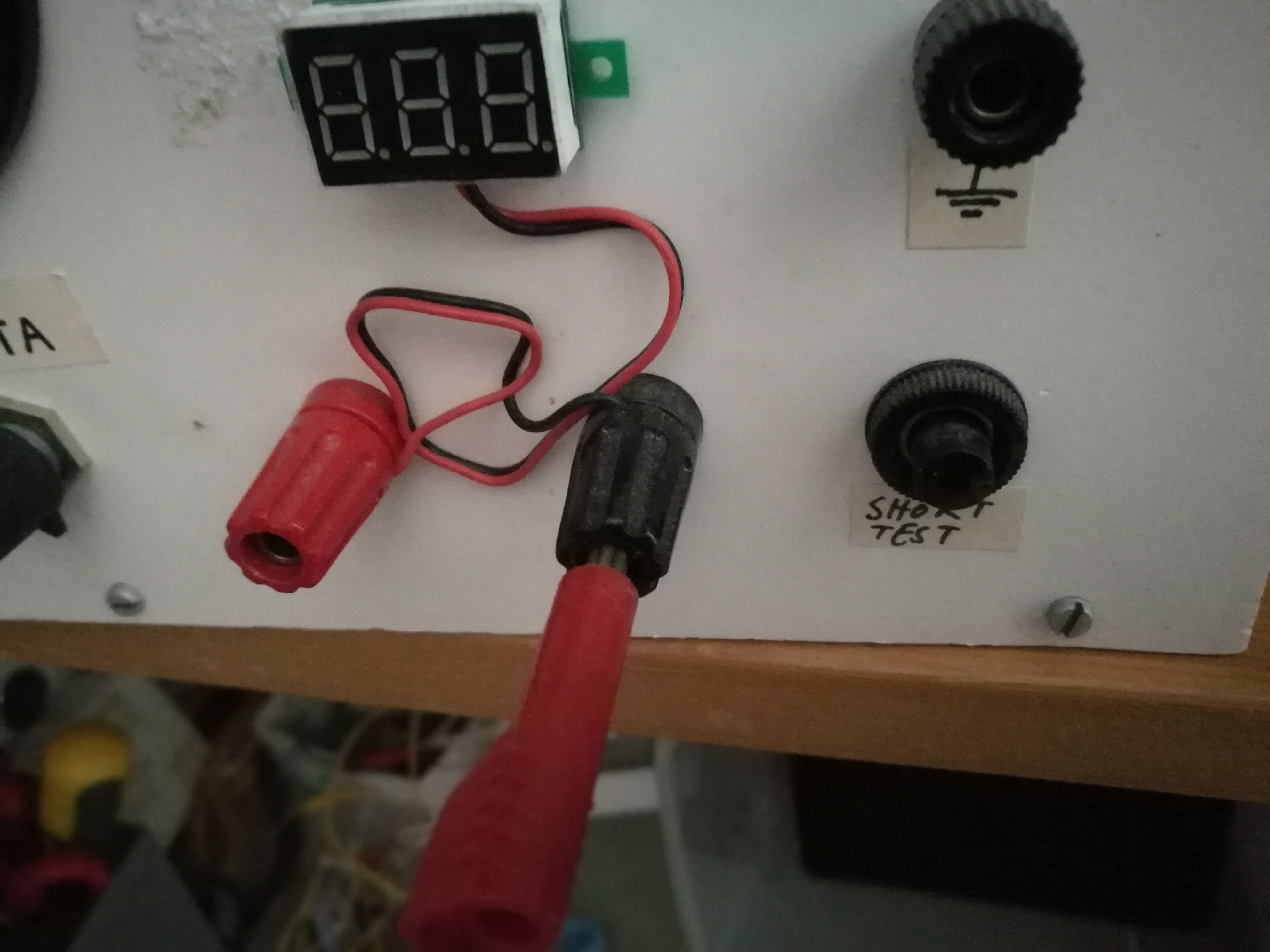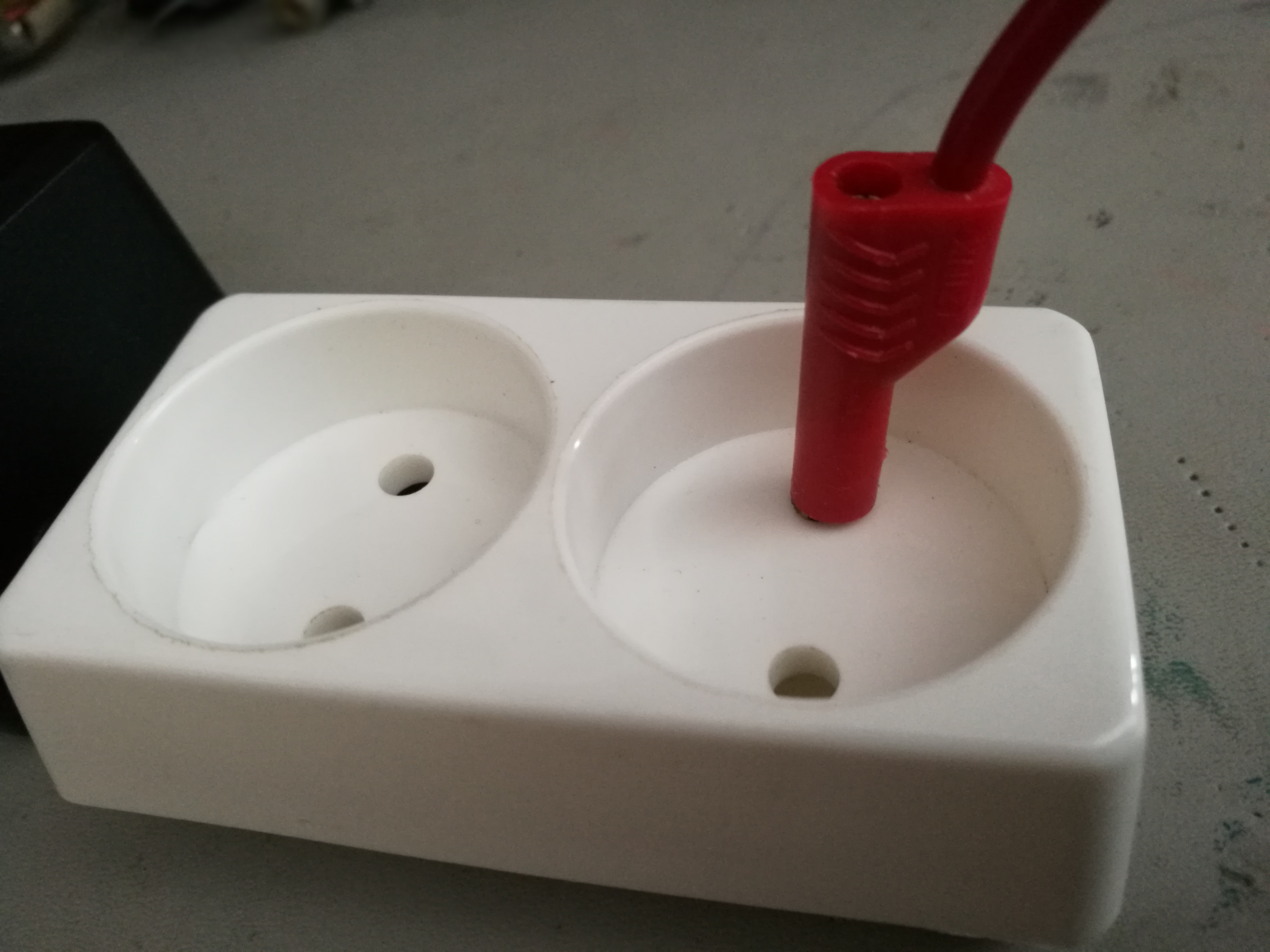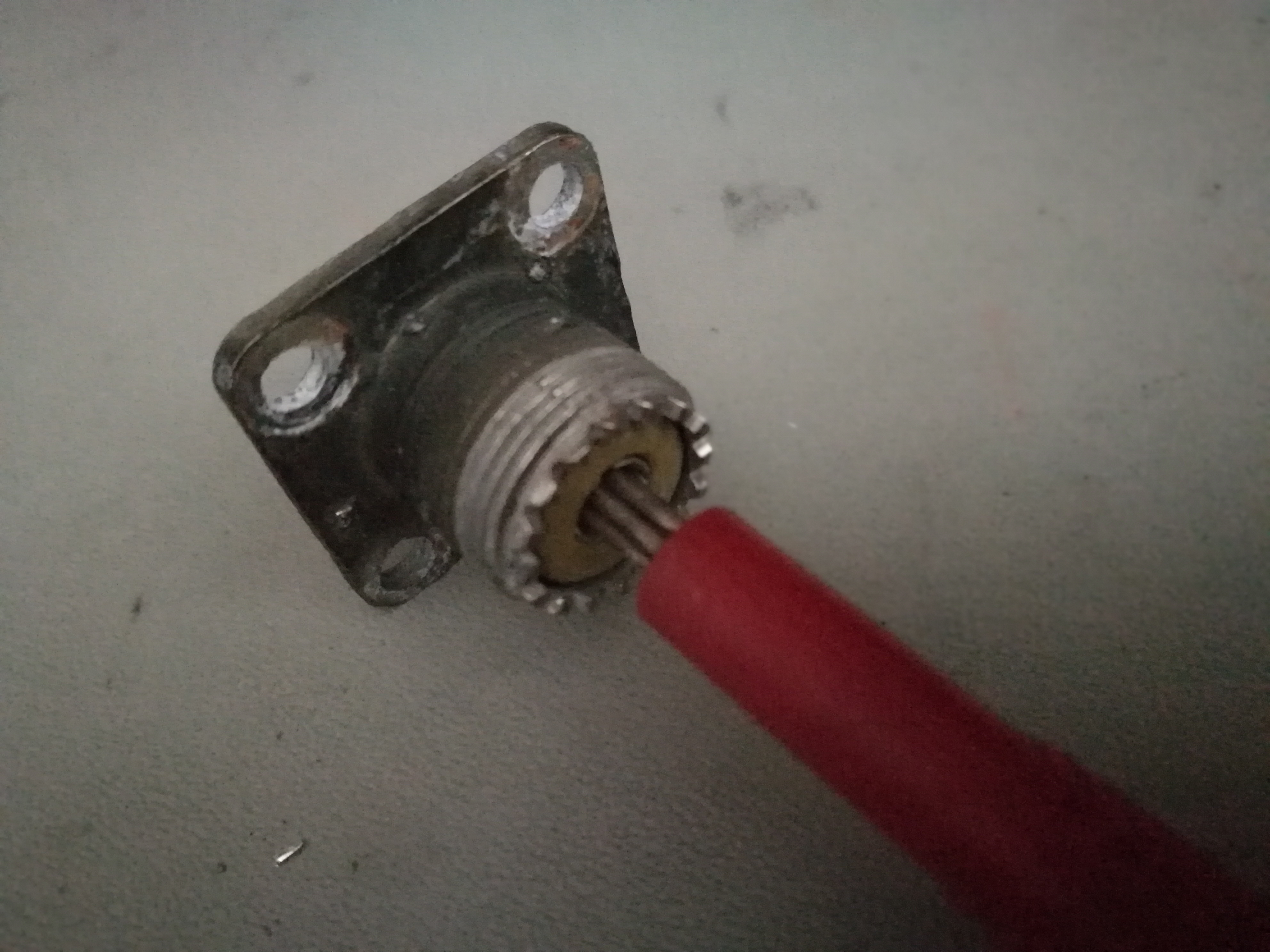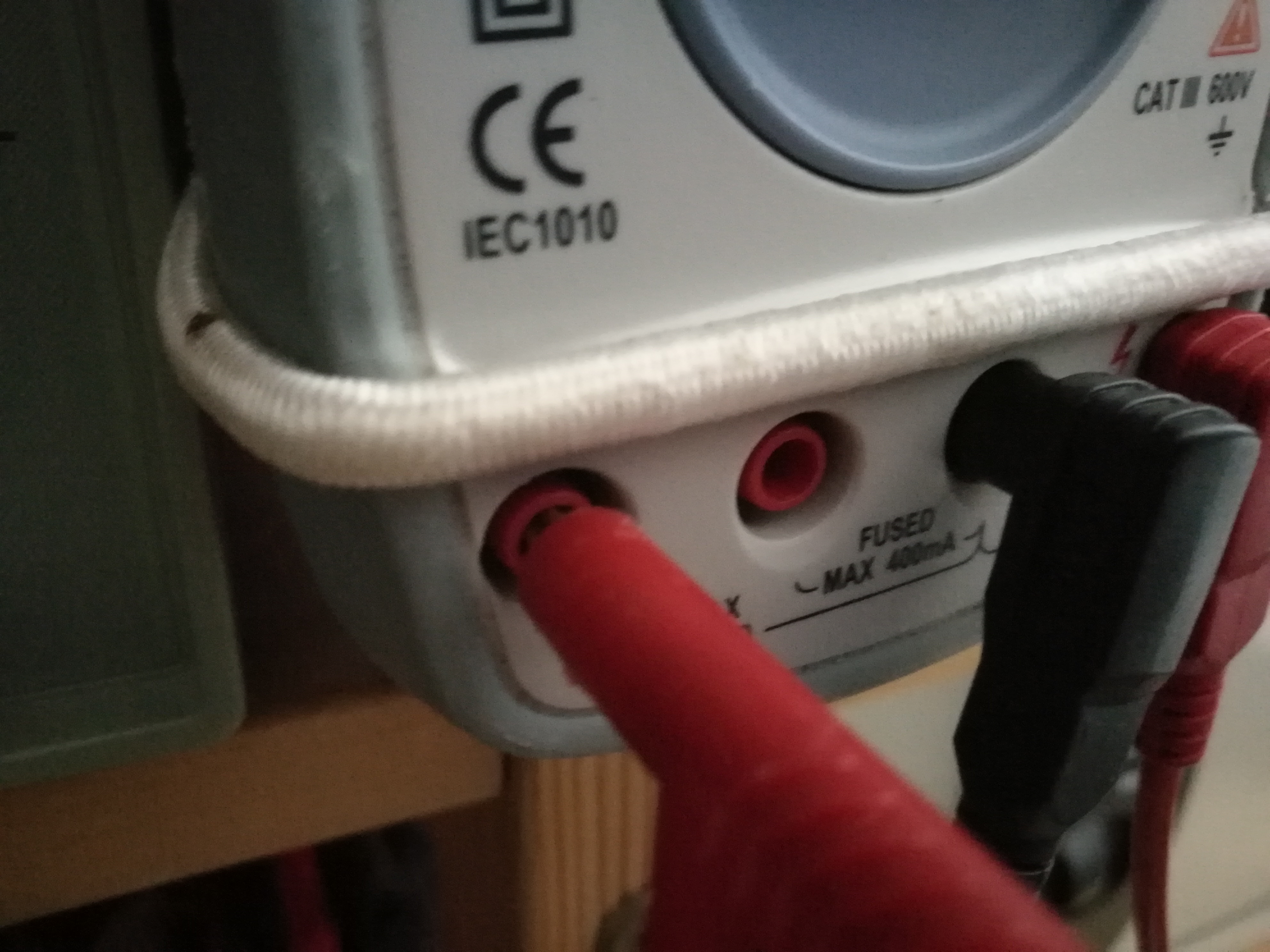https://en.m.wikipedia.org/wiki/Banana_connector
A banana connector is a single-wire (one conductor) electrical connector used for joining wires to equipment. The term 4 mm connector is also used, especially in Europe,because the pin’s diameter is nominally 4 millimetres (0.16 in).The pin has one or more lengthwise springs that bulge outwards slightly, giving the appearance of a banana.
The original plug consists of a cylindrical metal pin about 20 millimetres (0.79 in) long.However other sizes have emerged, such as 15 millimetres (0.59 in) pins, which can commonly be found in the US. Banana plugs and cables are typically rated for 30 V at 15 A, but there are versins rated up to 30A. Typical applications are test cables on electronics laboratories and speaker connections on HiFi systems.
Banana plug connected to power supply:

In most European countries, the standard mains power receptacle will physically accept banana and even US-style “double banana” plugs (the standard US pin spacing of 3/4 inch (19.05 mm) is close enough to the mains plug spacing of about 19 mm, and the pin diameter is also compatible), leading to a risk of electrical shock.

A typical design is now required (IEC 61010) on digital voltmetertest leads and several other measurement and laboratory equipment. In this design, the metal banana plug is entirely sheathed in plastic and presses into a deep recess in the DVM. The sheathed male plug will not work with an unsheathed female socket, but an unsheathed male plug will fit a sheathed female socket.This kind of sheathed banana connectors are typally used up to 1000V voltages.
Last but not least: Screw locking Banana.The UHF connectoris a threaded RF connector design RF connector useable up to 100 MHz (typically used for HF and lower VHF frequencies). Thsi connector has approximately 0.156 inch (4mm) diameter pin and socket for the inner conductor. It is possible to mate UHF connector female with banana plug.


21 Comments
Tomi Engdahl says:
Tip – Banana Plugs into AV Amp Speaker Wire Binding Posts
https://www.youtube.com/watch?v=9zuchv9-XvQ
How to attach speaker wires with banana plugs into Amps that use binding posts.
Comments:
Wow, never knew that about the lugs inside the posts.
Very useful post. Thanks very much. I thought I was going nuts – and starting to swear – until I thought let’s search on t’internet and up pops you with this gem !
Why do the manufacturers even bother to put those plugs in at all? It’s inconvenient for the consumer and adds a small cost to the manufacture.
…so why do they have those caps in???
It has to do with EU regulations, the posts have to be made so they don’t accept a regular power plug, which in the EU is the same size as a banana plug.
“EU health and safety” gone crazy rules though
In the EU using banana plugs in consumer electronics is illegal. They can be connected to our mains wiring socket since the spacing and the hole diameter happens to be the same. So as a precautionary measure they’re plugged as such and if you remove them, it’s on your own responsibility. (and this was after a bunch of people were killed by goofing around with banana plugs not knowing what goes where)
If it was mentioned in the manual how to remove them, the manufacturer would be breaking the law.
Tomi Engdahl says:
EEVblog #1052 – BEWARE Crap Banana Plugs!
https://www.youtube.com/watch?v=ZASKMqgrY70
Trap for young players, beware of crap quality banana plugs!
Dave discovered his gold plated rotating spring leaf lantern style contact banana plugs are craptacular!
Tomi Engdahl says:
Why are banana plugs prohibited in Europe?
https://hardforum.com/threads/why-are-banana-plugs-prohibited-in-europe.1269467/
Bought an Onkyo AV receiver today and while looking in the manual section for speaker hookup it told you how to use banana plugs but it also mentioned that banana plugs are prohibited in Europe? Why is that?
They are not legal for use in europe because they can be plugged into a wall outlet!! WBT makes a european legal type and it has an extra plastic pin to keep some chucklehead from plugging it into mains voltage.
European electric wall plugs are round, and the same size of a standard banana plug.
Yes we in the UK were not too happy about this as we have a totally different (and I may add far superior) power socket and plug setup with square pins and also the socket has a covering mechanism that only opens up access to the live and neutral points once the longer earth pin has gone in. This saves a baby sticking a knitting needle in the live socket etc. Oh and it has a proper fuse as well. Apparently the eurozone is always hinting at making us switch to their lower standard but if you visit say France or Spain all you see is euro sockets hanging off walls with wires on show.
My excuses, though my point still stands… an UK/US installation is more likely to burn than an EU installation.
That’s why you use normal banana plugs for audio / low power outlets and the legal ones for high power outlets and labs.
Oh and btw… your multimeter plugs can ONLY be used for measurement purposes.
Don’t try to run high currents trough it! they might ‘ seem’ safe because of the plastic tube but they’re in the best case made from silicone-rubber or lower quality isolation. Heat it up and it’ll melt.
Banana plugs “for use in U.S / Canada only”
http://www.audiokarma.org/forums/index.php?threads/banana-plugs-for-use-in-u-s-canada-only.129097/
Tomi Engdahl says:
https://www.reddit.com/r/audiophile/comments/26t378/til_banana_plugs_are_banned_in_europe/?st=jdfw2a6t&sh=8475d88b
Incidentally, aside from US power sockets which have flat connectors, banana plugs would fit into pretty much every power socket in the world, as they all have round holes.
I’m an electrical engineering student in Greece, and i use this plugs all the time in labs.
The joined banana plugs are the same size as the AC wall outlet size. My UK built speakers have connectors which will accept banana plugs but not joined due to spacing.
They’re sold everywhere, not banned.
When you buy speakers or amps the openings for banana plugs are plugged with some plastic. But it’s usually very easy to get the plastic out and just use banana plugs.
This is hilarious, what could possibly be the reason? Prevent people from plugging their speakers into a generator?
I’m sure it’s an enforcement issue. As in: the regulation is too stupid to enforce
Returned to HiFi – banana plugs banned in EU!
https://www.whathifi.com/forum/hi-fi/returned-to-hifi-banana-plugs-banned-in-eu
Sooooooo, after many years away from HiFi, I’ve just found out that banana plugs are banned in the EU. The brand new amp and speakers I’ve just bought, thankfully, were able to accept my banana plugs for the speaker cables after I popped out the blanking pins.
Wonder if its because the plugs fit pathetic euro mains sockets? The eu should ban all metal pointy things. And bananas.
A quick google reveals that this has been around since at least 2008. Basically, the twin banana plug’s spacing of 3/4 inch is very close to the 19mm of the continental 220V power outlet, so that it is easy to insert the twin banana plug into the power socket. Since amps also have power leads, the possibility of confusion is quite real.
UK have a different plug socket.
Tomi Engdahl says:
Europe and Banana plugs. What’s up with that?
https://groupdiy.com/index.php?topic=45287.0
Yes, that’s it pretty much.. banana plugs that can go into mains outlets and they even insist on covering binding posts on high power amps if the output voltage is high enough.
Doesn’t it warm your heart to know the government cares about your safety so much?
I believe that’s pretty much it… Just like if somebody wanted to use a 110 outlet for an amp output here in the US…
…and a little more. Anything that carries more than 25Vac or 35Vdc must be protected so you can’t touch it. With banana plugs, there is always the risk of them not being fully plugged-in, leaving bare metal.
Most A/V amps come with bananas because they’re less than 80W per ch into 8ohms, but they come with a plastic thingy plugged-in, so a kid can’t touch the metal with his 5mm fingers ??? .
Officially you’re supposed to use bare wires or fork connectors (personally I think there are more risks of touching the conductors, but what do I know?).
Practically, you take off the plastic thingies and use banana plugs. Who will enforce the regulation?
I have to agree, re: bare wires. A billion amp channels have been destroyed by bare wires shorting.
the banana plug will fit into a Euro style 230volt outlet. imagine the problems that could cause, both firehazard if plugging a speaker into the wallsocket, the danger to any person trying such things and other possible problems
Funny thing is, here in the US we have the practice of installing the mains outlets oriented so that they look like faces. This is incorrect according to the building code. I install mine with the ground prong on top, and people will spot it right away and puzzle over it. The idea is that if the plug does not seat all the way, and something conductive falls across it, it’s safer to have the ground up top. Never had anything fall that way, but there’s no downside to doing it like that – if you don’t count puzzled looks.
Tomi Engdahl says:
http://www.apogeeacoustics.com/oldforum/007483.html
…that the use of banana plugs is banned in all IEC-compliant countries.
Is this true? What is the rationale?
That’s exactly it – in some European countries banana plugs, are the same plug as used in AC outlets and worse yet, the “stereo pair” spacing was exactly the same.
This is why audio makers had to alter their post spacing a few years back if they accepted bananas, so that kiddies wouldn’t plug the speaker cables into the wall.
Tomi Engdahl says:
CABLE MADNESS: CRAZY CONNECTORS WE CAN DO WITHOUT
https://www.wired.com/2008/09/cable-madness-a/
Banana plugs
These once ubiquitous speaker connection plugs slot into the binding posts found on most speakers. The problem? They also fit quite easily into European power outlets, which led to them being banned on new equipment.
Tomi Engdahl says:
In Europe, using banana plugs to connect speakers to an audio amplifier is prohibited.
They are not legal for use for speaker connections in europe because they can be plugged into a wall outlet!!
They are physically compatible with the EU wall sockets! Neat.
https://www.reddit.com/r/audiophile/comments/26t378/til_banana_plugs_are_banned_in_europe/
https://hardforum.com/threads/why-are-banana-plugs-prohibited-in-europe.1269467/
Tomi Engdahl says:
Difference Between BFA and Banana?
https://forum.polkaudio.com/discussion/179983/difference-between-bfa-and-banana
So I keep seeing this “BFA Style” connector.
What the heck does BFA stand for? and how is it different from a Banana connector?
It seems like the BFA Style is this banana connector with the squiggly/cutout in it, and a regular banana connector has the spring mechanism all around, or in the 4 quadrants?
British Federation of Audio…created by the Eurocrats due to safety concerns
So that you don’t do sumtin’stupid like plug your audio connector into the euro electrical socket
Banana plugs are actually illegal in Europe, hence the reason that when you receive amps, they may have those red plug caps stuffed in the the amp terminals
Tomi Engdahl says:
mains cable as speaker wire
https://www.avforums.com/threads/mains-cable-as-speaker-wire.1397951/
Tomi Engdahl says:
Difference Between BFA and Banana?
https://forum.polkaudio.com/discussion/179983/difference-between-bfa-and-banana
What the heck does BFA stand for? and how is it different from a Banana connector?
It seems like the BFA Style is this banana connector with the squiggly/cutout in it, and a regular banana connector has the spring mechanism all around, or in the 4 quadrants?
British Federation of Audio…created by the Eurocrats due to safety concerns
So that you don’t do sumtin’stupid like plug your audio connector into the euro electrical socket
Banana plugs are actually illegal in Europe, hence the reason that when you receive amps, they may have those red plug caps stuffed in the the amp terminals
You’ll get more surface area contact with a BFA, has the whole barrel makes contact, not just the raised portion of a standard banana. Will it make any difference? I doubt it.
Connectors are all about a good connection. And maintaining that connection under all circumstances.
Don’t misunderstand my comment. I am a believer in cable differences, but I don’t see how the little bit of difference in contact area would affect the tonal characteristics of a cable. Now, If I were designing a cable form the ground up, I’d go with BFA’s simply because more surface area contact certainly doesn’t hurt anything–but I wouldn’t stress about it on a cable that only came with standard bananas.
Not all banana plugs are created equal. The ones dannylighting posted are poorly designed and constructed with minimal contact area. Compare them to high quality banana plugs such as the ones from MIT and the differences become obvious. The MIT’s have 6 springs with a solid center post connected to a solid dome tip.
Tomi Engdahl says:
Technology : Safe alternative to banned bananas
https://www.newscientist.com/article/mg15320673-800-technology-safe-alternative-to-banned-bananas/
A recently amended European safety standard effectively bans the “banana
plug” that is used to connect loudspeaker leads to an amplifier. This plug,
which takes the form of a springy metal pin, is small enough to fit into the
5.5-millimetre openings of a European mains socket. Anyone who plugs speaker
leads into the mains could receive a lethal electric shock (Technology, 6
January 1996, p 20).
The British Federation of Audio, which represents all the major hi-fi
manufacturers, has been working with A&R Cambridge, maker of Arcam hi-fi
equipment, on a plug and socket that complies with North American safety
standards as well as the new European standards. The BFA connector is a
6-millimetre metal cylinder sleeved in insulating plastic and secured on the end
of a cable. Speakers and amplifiers are fitted with plastic cylinders that
shroud a central metal pin. There are no bare metal parts and the plug is too
big to be pushed into a mains socket.
An added advantage of the new connectors is that no one can touch the wires
carrying audio current from the amplifier. On high-power systems this can be
strong enough to give a shock. They also solve another problem. If the bare
metal pins of a banana plug touch, they can short out the amplifier and damage
it. The sheathing on BFA plugs will prevent this happening.
Tomi Engdahl says:
https://www.wago.com/global/accessories/banana-plug/p/215-212
Tomi Engdahl says:
“throughout the European Union, the sale of audio amplifiers and loudspeakers that accept banana plugs is prohibited as is the sale of loudspeaker leads terminated in such plugs.”
https://en.m.wikipedia.org/wiki/Banana_connector
Tomi Engdahl says:
The Complete Guide to Banana Test Plugs
https://www.warwickts.com/2149/Guide-to-Banana-Plugs
Banana Plugs are spring-loaded, single-wire electrical test connectors used for joining wire to electrical test equipment or electrical circuit boards. Banana connectors come in either, Banana Plugs (male) or Banana Sockets (female). This short article identifies the different sizes and different types of banana plugs, as well as offering guidance on what banana test plug connector suits your specific application.
Tomi Engdahl says:
https://en.m.wikipedia.org/wiki/Banana_connector
Tomi Engdahl says:
The Complete Guide to Banana Test Plugs
https://www.warwickts.com/2149/Guide-to-Banana-Plugs
Banana Plugs are referred to as a male connector and commonly found in either 4mm (standard) or 2mm (miniature) pin plug sizes. Banana plugs are designed to connect into Banana Sockets (Jacks) which again are available in either 4mm (standard) or 2mm (miniature) socket sizes
The Banana plug features a unique contact tip. The cylindrical pin features ‘metal-leaves’ that bulge outward to create a strong contact in a socket. The leaves prevent the connection failing when it’s subject to movement or vibrations and offers more reliable testing. Banana Plugs are typically connected to wire by; screw, solder or crimp.
Banana plugs can be found in a range of colours, the most common being black and red. It’s common to see them follow the standard colour codes; 0 – Black, 1 – Brown, 2 – Red, 3 – Orange, 4 – Yellow, 5 – Green, 6 – Blue, 7 – Violet, 8 – Grey, 9 – White.
Banana Plug Sizes: 4mm Vs. 2mm
Banana plugs are typically available in two different sizes, standard and miniature. In Europe, a standard banana plug refers to a 4mm plug. Generally all standard Banana Plugs are compatible with all 4mm Banana Sockets (Jacks). A miniature or mini banana plug is a smaller design of the standard banana plug. Miniature Banana Plugs can vary in size between 3mm and 2mm
Banana Plug Protective Sleeve Types
Banana Plugs typically offer three different types of protective sleeve options; unshrouded, retractable shrouded and shrouded. Banana Plugs with a shrouded sleeve are often used in High Voltage applications for safety requirements.
Unshrouded Banana Test Plugs
Unshrouded banana plugs are also called unsheathed banana plugs. They feature a bare pin that is uninsulated and visible. The unshrouded banana plug is commonly used in lower voltage (30 – 70 VDC) electrical testing applications.
Retractable Sleeve Banana Test Plugs
A banana plug with a retractable sleeve has a spring-loaded shroud cover that slides out of the way when the pin is inserted into a shrouded or unshrouded banana socket or jack. The retractable shroud improves safety and is typically used in higher voltage applications.
Shrouded Banana Test Plugs
Shrouded banana plugs are also called sheathed banana plugs. They feature insulation (protective plastic sleeve) around the connector to avoid accidental contact with the metal plug in high voltage situations. Shrouded banana plugs are a common requirement for CAT II & IV (600-1000V) applications. Shrouded banana plug will only fit into shrouded banana sockets (jacks). Remain safe when electrical testing high voltages with shrouded banana plugs.
Complete Guide to Banana Test Sockets (Jacks)
https://www.warwickts.com/2144/Guide-To-Banana-Sockets
Banana Sockets (Jacks) are female electrical connectors that a Banana Plug inserts into to make a connection. Banana Sockets (Jacks) are commonly found in either 4mm (standard) or 2mm (miniature) socket sizes.
Standard Banana Socket (Jack) accepts either; unshrouded or retractable shrouded 4mm (standard) Banana plugs irrespective of the pin leaf number. However, a standard Banana Socket cannot accept a standard Shrouded Banana Plug.
Shrouded Banana Socket (Jack) accepts; shrouded, unshrouded and retractable shrouded 4mm (standard) Banana plugs irrespective of the pin leaf number.
Banana Sockets (Jacks) can be found in a range of colours, the most common being black and red. It is common to see them follow the standard colour codes; 0 – Black, 1 – Brown, 2 – Red, 3 – Orange, 4 – Yellow, 5 – Green, 6 – Blue, 7 – Violet, 8 – Grey, 9 – White.
Banana Sockets (Jacks) Sizes: 4mm and 2mm
Banana Sockets (Jacks) are usually available in two sizes, standard and miniature. In Europe, a standard banana socket refers to a 4mm socket. Generally all standard Banana Sockets are compatible with all 4mm Banana Plugs. A miniature or mini Banana Socket is a smaller version of the Standard Banana Socket.
Standard Banana Sockets are frequently found in; automotive diagnostic, industrial and electrical testing applications. Specific applications affect connector body type and preferred colour.
Banana Sockets (Jacks): Sleeve Types
Shrouded (Safety) Banana Test Sockets
Shrouded Banana Sockets (Jacks) are also referred to as Safety Banana Sockets. They feature insulation (protective plastic sleeve) around the connector to avoid accidental contact with the metal socket in high voltage situations. Standard (4mm) Safety Banana Sockets accept Standard (4mm) Banana Plugs.
Unshrouded (Uninsulated) Banana Sockets
Unshrouded Banana Sockets (Jacks) are also called uninsulated banana sockets. They feature a bare socket that is uninsulated and visible. The uninsulated banana socket is commonly used in lower voltage electrical testing applications.
Banana Sockets (Jacks) can have different types of connection terminals at the front end which enables the socket to connect to different electrical fixtures or circuits. Bindings Posts are one type of Banana Socket (Jack).
- Banana Sockets (Jacks) Conclusion
Banana Sockets (Jacks) are a common and important component in many electrical applications. Joining wires and leads to equipment correctly is invaluable for safety and performance. Be sure to choose the correct; size, sleeve type, terminal style and colour for your electrical application.
Tomi Engdahl says:
How many amps can a banana plug handle?
Typical current rating is 15A
There are also banana plug rated for 20A, 35A or 36A
Mini banana plugs (2 mm) are typically rated for 5A
https://www.muellerelectric.com/docs/Banana-Plugs.pdf
Tomi Engdahl says:
https://www.reddit.com/r/audiophile/comments/26t378/til_banana_plugs_are_banned_in_europe/
Tomi Engdahl says:
https://www.facebook.com/groups/avdisasters/permalink/6140095576118902/
Tomi Engdahl says:
EU bureaucratic does not like hifi fools in going bananas. Use of normal banana plug for hifi speaker connections is banned because it fits too easily to European mains outlets with shocking results.